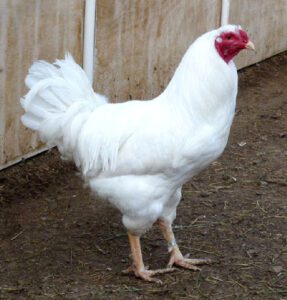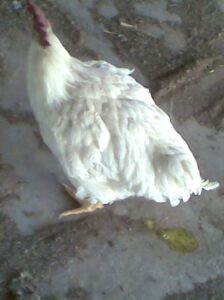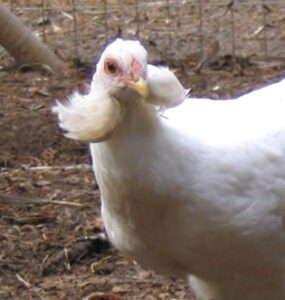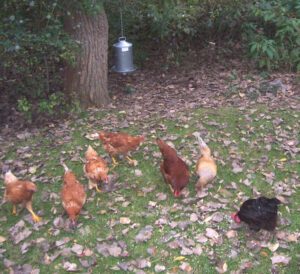The Shamo chicken is an hard feathered Asiatic Game breed originating in Japan. Although the breed was developed in Japan, but it’s ancestors came from Thailand (which was known as Siam) between the 17th and 19th centuries.
Shamo chicken was developed mainly for using as a fighting bird. And the breed was imported into many countries mainly for this reason. There are many different kinds of Japanese Game chickens, but currently the Shamos are best known.
Breeders looked to the strength and endurance of these original breeds when creating the Shamo breed. The Shamos have been selectively bred for hundred years and now is very different from the original stock.
Actually the Shamo chicken is a strain of the Asil chicken. Which was taken to Thailand and Taiwan and from there to Japan. The real origin place of Shamo is Sindh, Pakistan. And secondary origin place is India.
In different regions of Japan, the Shamo chicken can be found in different variety of colors and sizes. Different regions favoring fowls of different sizes for boxing. The varieties are; O-Shamo, Chu-Shamo and Ko Shamo.
O-Shamo chickens are larger birds with roosters weighting 5.62 kg and hens 3.4 kg. Chu-Shamos are medium birds with roosters weighting 3.63 kg and hens about 2.72 kg. And the Ko-Shamo chickens are smaller birds with roosters weighting 1.81 kg and hens weighting 1.36 kg.
In hopes of avoiding the extinction of Shamo chicken, the Japanese government placed the bird under protection of low in 1941. The breed is available in the United States. It was first imported to the United States in 1874.
But the majority of the chickens In America can be found in the Southern states. The Chu-Shamo and O-Shamo designations are recognized in the United Kingdom. The Australian Poultry Standards have only one form of Shamo, which has a minimum weight of 3 kg.
The Shamo chicken breed was first recognized and admitted into the American Poultry Association’s Standard of Perfection in 1981. Today the breed is kept as an ornamental bird in some countries.
And also raised as game birds in some countries. Now the Shamo chicken is listed in the Watch category of the American Livestock Breeds Conservancy’s Conservation Priority List.
Origin and History of Shamo Chicken
Shamo chicken traces its origin to Japan, and its history can be dated back to the early 17th century (during the Edo period). It is believed to have been developed through the crossbreeding of Malay and other Southeast Asian chickens with native Japanese fowls
Shamos are well known for their muscular build, upright posture, and formidable fighting abilities (as they were initially bred for cockfighting). They have evolved and adapted to various regions and climates over the centuries.
Characteristics
Despite being a popular game chicken, Shamo chicken is also known for being the second tallest breed after the Malay chicken. In appearance, the Shamos are large and tall chicken with upright, nearly vertical, body carriage.
They have well muscled thighs, wide and muscular body. They have hard and closely held feathers that often do not completely cover their bodies. They have heavily boned broad shoulder. They are taller and less compact than the Asil chickens, and lack the exaggerated curves of the Malay chicken.
The tails of the Shamo chicken are small and generally follow the line of the back sloping downward to the ground. They have smaller sized bright red colored pea comb. Their earlobes are small and bright red colored.
Their wattles are also of bright red color, which is very small or missing entirely. They have yellow colored beak and legs. And their eyes are of pearl color. The plumage color vary depending on the color variety.
For example; White variety has standard white plumage, Wheaten variety has standard wheaten plumage, Black variety has standard black plumage, Dark variety has standard dark plumage, Black Breasted Red variety has standard black breasted red plumage, Spangled variety has standard spangled plumage, Buff Columbian variety has standard buff columbian plumage and the Brown Red variety has standard brown red plumage.
American Poultry Association recognizes only four color varieties, which are; Black, Black Breasted Red, Dark and Red. On an average, standard Shamo roosters weight 5 kg and hens about 3.18 kg. And the bantam roosters weight about 1.25 kg and hens about 1 kg. Photo from Wikipedia.
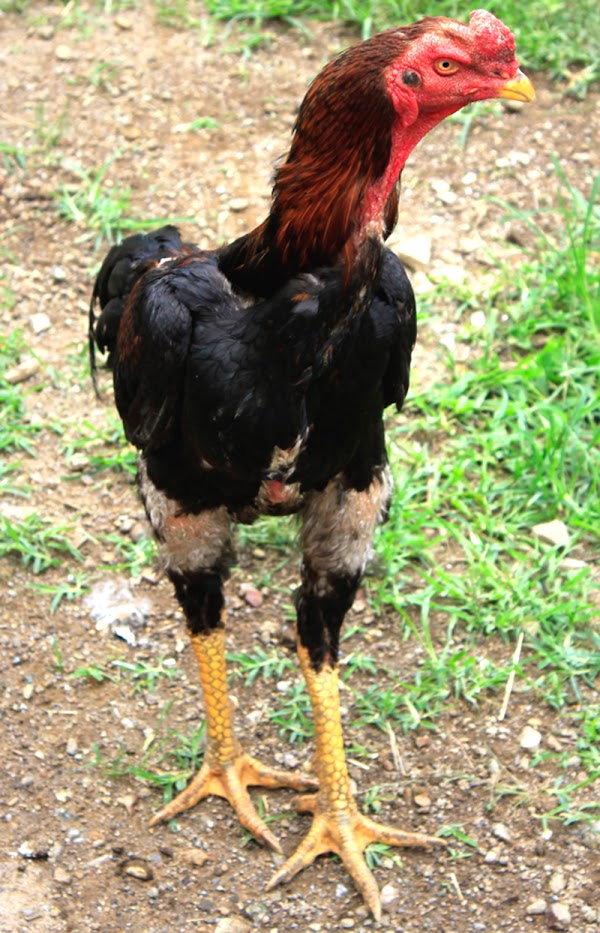
Behavior/Temperament
The Shamo chicken has similarity to the Asil chicken. They are usually easy to handle and the hens are pretty calm. But the roosters can be territorial and aggressive towards each other. Even the hens can be aggressive towards other chickens. And fights among the baby chicks is also a problem.
The roosters must be kept separated form other roosters for preventing them from fighting to the death. Although the Shamo chicken likes humans. And they can be tamed easily with proper care from a young age. The hens are good layers than many of the other Asiatic game breeds. They lay medium sized light brown colored eggs.
Hens go broody and are excellent mothers. The chicken breed produce good amount of meat. But their meat has been described as tough and is not favorable by everyone. They are great foragers and good for free range, but can’t do well in confinement.
Housing Requirements
Like many other chicken breeds, the Shamo chickens also have specific housing requirements. They need secure housing to ensure their good health and comfort. They need spacious housing sytem due to their large size and upright stature
Ensure good ventilation to prevent heat stress. Try to make the house highly secure to provide protection from predators and adverse weather conditions. Arrange a clean and dry bedding area for your birds, as Shamo chickens are prone to leg problems. So, providing a soft substrate helps to prevent injury.
Provide adequate perches and nesting boxes depending on the number of birds. Providing them with a run will be very beneficial for exercising and foraging. However, meeting all the housing requirements is very important to maintain the health and happiness of these chickens.
Dietary Requirements
The dietary requirements of Shamo chickens are relatively simple, but very important for their health and productivity. They are robust birds and they require a balanced diet. They require good food consisting of high-quality poultry feed that provides essential nutrients like protein, vitamins, and minerals.
Shamos generally need more protein in their diet as compared to smaller chicken breeds, mainly because of their larger size and active nature. Supplementing their diet with grains, vegetables, and occasional protein-rich treats can help to keep them healthy and active.
Along with providing them with good quality and nutritious food, try to offer them access to clean, and fresh water at all times. Providing enough water is essential for proper digestion and hydration.
Reproduction/Breeding
Breeding Shamo chickens is relatively easy and simple. Keep good ratio of hens and roosters and your birds will do the rest. Always try to select good quality and healthy birds for breeding purpose.
Shamo hens are known to be broody and can hatch and raise their chicks. Some breeders also prefer using incubator for better control over the hatching process.
The chicks require a warm and secure environment after hatching. Give attention to proper nutrition, health, and environmental conditions for raising the chicks.
Caring
Taking good care of the birds is very important. Caring for Shamo chickens involves providing them with a good housing system, nutritious food and other essential health care. Perform regular health checks-ups, vaccination, and prompt treatment of any illnesses or injuries.
Uses
Shamos were historically bred for cockfighting due to their strength and fighting prowess. And today, they still retain these traits in some regions where such practices are legal.
Today, the Shamos are popular for their meat, which is known for its rich flavor and firm texture. They can also serve as ornamental birds. And they are admired for their impressive size, upright posture, and striking appearance.
Popularity and Price
Popularity of Shamo chickens varies from place to place. It is highly popular in Japan, the United Kingdom, and certain parts of Southeast Asia. They are highly regarded for their historical significance, fighting abilities, and meat quality.
Price of Shamo chickens is much higher as compared to other common chicken breeds. Although, exact price of these birds depends on some factors such as age, pedigree, and physical characteristics.
Lifespan
Average lifespan of these chickens is between 5 to 8 years. Although, their lifespan can vary depending upon various factors (including genetics, diet, living conditions, and healthcare).
Pros and Cons
Like all other chicken breeds, the Shamos also have some pros and cons. Here we are trying to list the top pros and cons.
Pros:
- Impressive size
- Good meat quality
- Hardy nature
- Cultural and historical significance
- Beautiful and unique appearance
- Very strong and hardy
Cons:
- Aggressive temperament
- Large space requirements
- Require special care
- Leg problems
- Legal restrictions
- High cost

Is Shamo Chicken Good for You?
Yes, these chickens are good for you if you
- Want to have some beautiful birds with unique appearance.
- Are willing to raise game birds.
- Want to raise a few good quality chickens.
- Want to keep some chickens for high quality-meat production.
Special Notes
Shamo chickens have significant cultural and historical significance in several regions (especially in Japan and Southeast Asia). It is considered a national treasure in Japan, and has deep-rooted historical ties. The Shamo played a very important role in Japanese culture (especially in cockfighting).
Along with their very important role in in sports, Shamo chickens were regarded as a symbol of perseverance and resilience. They also have a strong presence in traditional games and cultural festivities in Southeast Asian countries (like Thailand and Malaysia).
| Breed Name | Shamo |
| Other Name | None |
| Breed Purpose | Ornamental/Fighting |
| Breed Temperament | Can’t Bear Confinement Well, Aggressive, Likes Humans not Chickens |
| Breed Size | Large |
| Broodiness | Frequent |
| Comb | Pea |
| Climate Tolerance | Heat |
| Egg Color | Light Brown |
| Egg Size | Medium |
| Egg Productivity | Low |
| Feathered Legs | No |
| Rarity | Common |
| Varieties | Black, Black Breasted Red, Dark and Red are the four color varieties of Shamo chicken recognized by the American Poultry Association. |
| Country of Origin | Japan |
Frequently Asked Questions (FAQs)
The shamo is a very beautiful, powerful and lovely breed of domestic chicken which is raised mainly for ornamental purpose. It is also sometimes raised as pets, and these chickens are very adorable. The breed is also known for producing very high quality meat. Popularity of this chicken breed is very high, and also increasing gradually. That’s why many people are asking numerous questions about these chickens. However, here we are trying to list the most common questions about this breed of domestic chicken, and trying to answer them. Hope you will find your answer. Don’t hesitate to ask us if you have more questions.
What are shamo chickens good for?
The shamos are game chickens and they are kept mainly for cockfighting. Some people also raise them for their excellent meat quality. And the breed is also very good for keeping as pets.
Is shamo chicken good for meat?
Yes, the shamo chickens are very good for meat production. They produce a good amount of meat and their meat is of excellent quality.
How big is a shamo chicken?
The shamos are large, and tall chickens. They are typically 2.5 feet (30 inches) tall. They carry themselves in a nearly vertical position.
What are the main characteristics of shamo chickens?
The shamos have muscled thighs and a wide, muscular body. Their feathers are hard, close to the skin, and they often don’t provide complete coverage of the skin, with no feathers on their face or throat.
How do I know if my chicken is a pure shamo?
A pure shamo is a large and tall chicken with upright, nearly vertical, body carriage. They have well-muscled thighs, yellow legs, wide and muscular body. And they have hard, closely-held feathers that often do not completely cover their bodies.
Which is better Shamo or Asil?
The Asil chicken is considered more skilled in fighting because of their stronger body structure.
How much does shamo chicken cost?
Exact price of a shamo chicken depends on numerous factors. Price of a shamo chicken can vary from a few dollars to several hundred dollars.
How much does a shamo chicken weight?
Average body weight of the shamo rooster is about 5 kg, and 3.2 kg for the hens.
What are the color varieties of shamo chickens?
Black, Black Breasted Red, Dark and Red are the four color varieties of Shamo chicken recognized by the American Poultry Association.
Where the shamo chickens originated from?
The shamo chickens were originated form Japan.
How many eggs do shamo hens lay?
Generally, a shamo hen lay around 90 light-brown eggs per year.
How many eggs do Ko Shamo lay?
Ko shamo hens lay around 180 small white eggs per year.
How long do shamo chickens live?
Average lifespan of the shamo chickens is between 6 and 8 years. But some birds are also known to live for as long as 12 years.

